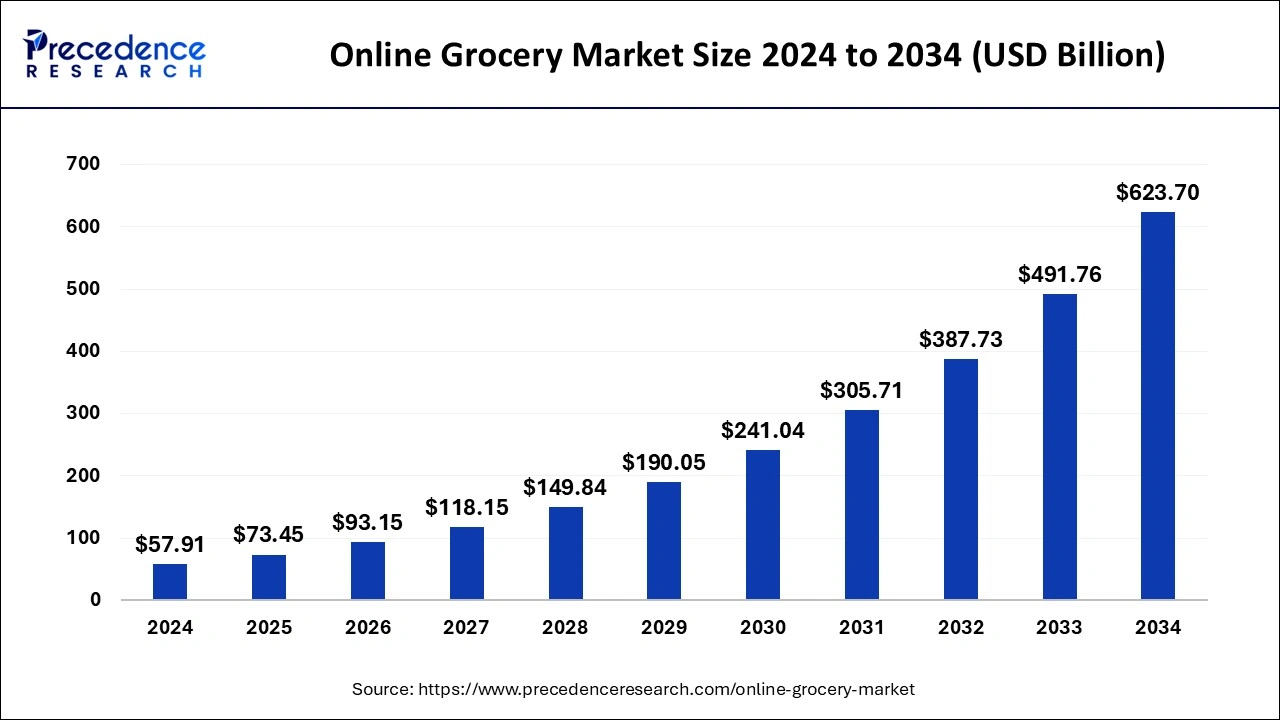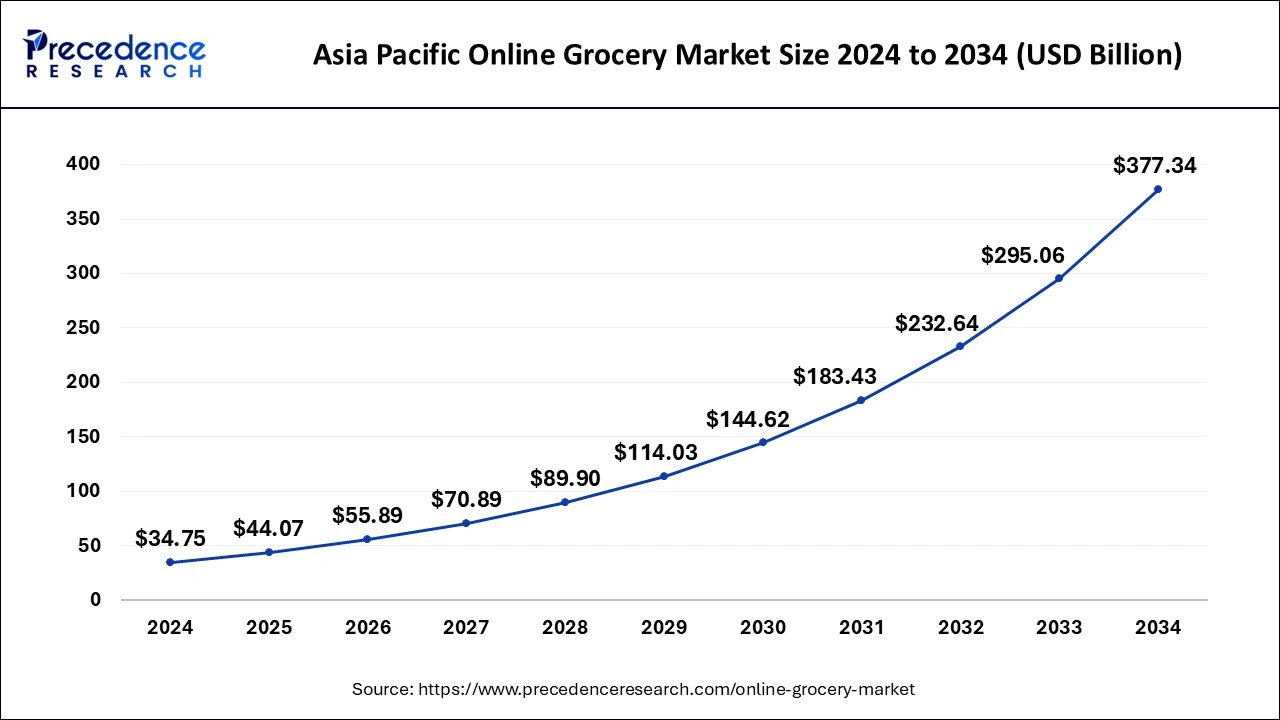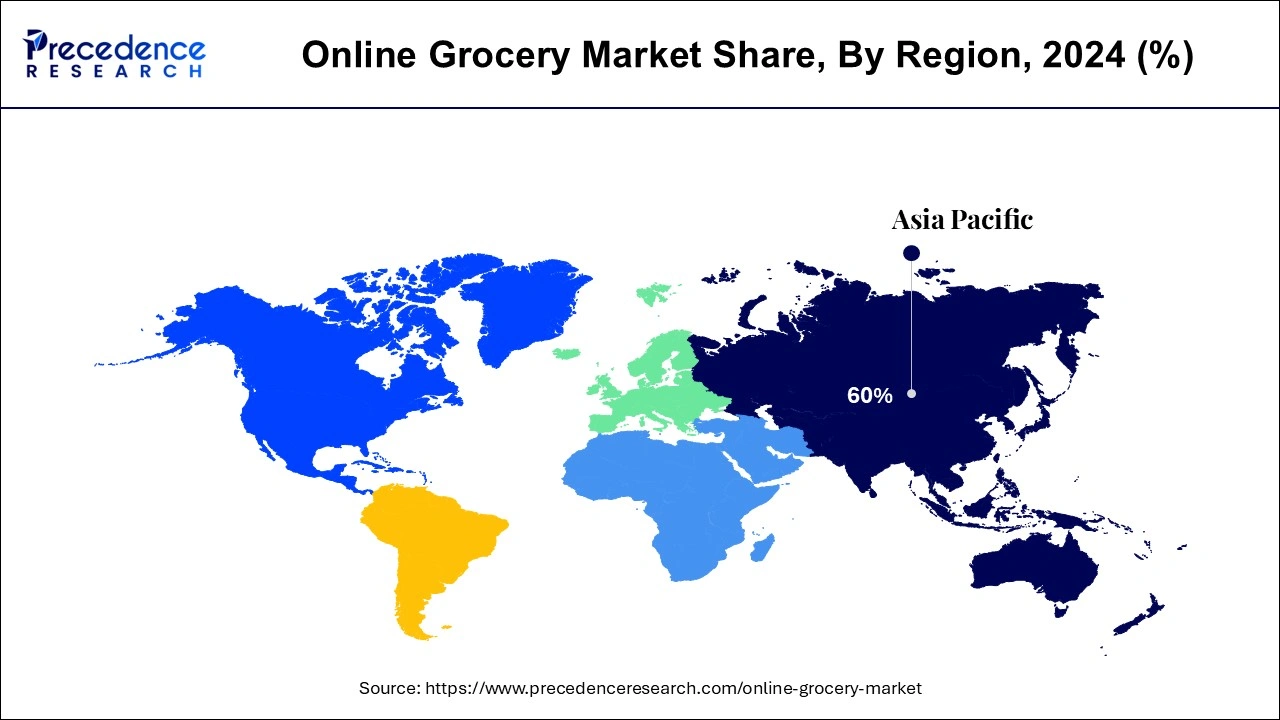List of Contents
What is the Online Grocery Market Size?
The global online grocery market size was estimated at USD 57.91 billion in 2024 and is anticipated to reach around USD 623.70 billion by 2034, expanding at a CAGR of 26.83% from 2025 to 2034.

Online Grocery Market Key Takeaways
- Asia Pacific dominated the global online grocery market with the largest market share of 60% in 2024.
- By product, the staples and the cooking essentials segment accounted for the highest market share of 34% in the year 2024.
- By product, the breakfast and dairy segment is expected to grow at a notable CAGR over the forecast period.
Role of AI in Online Grocery Sector
Artificial intelligence is bringing much-needed change in the industry by bringing in more aspects of personalization, operational efficiency, and good customer experience. Behavior analysis, browsing history, and past purchases are what AI is working on to recommend products, offer discounts, and display shopping interfaces accordingly. AI keeps inventory management at uptight levels, performing automations of some of their annoying tasks while offering dynamic price-setting functionalities based on real-time market situations. Additionally, AI smoothens the interaction using chatbots, visual search, and voice shopping while optimizing logistics from the time delivery happens to fuel consumption. It finally leads to less overstock and food waste, saving costs and augmenting efficiency to provide top-class, highly personalized, and economical shopping experiences for online grocery outlets.
Asia Pacific Online Grocery Market Size and Growth 2025 to 2034
The Asia Pacific online grocery market size was evaluated at USD 34.75 billion in 2024 and is predicted to be worth around USD 377.34 billion by 2034, rising at a CAGR of 26.93% from 2025 to 2034.

Asia Pacific dominated the global online grocery market with the largest market share of 60% in 2024.North America is forecasted to rise during the forecast period. Apart from these nations, India and China are considered to be very high potential markets for the platform. Due to digitization in India and China, which are Asia Pacific markets are expected to have a growth. The coronavirus lockdown had helped in a significant rise in online grocery sales in these regions.

The various government initiatives that are aimed at digitally empowering these nations, this market is expected to grow during the forecast. US is witnessing a steady growth in this platform. Several key players, Walmart Amazon.com Inc, Instacart etc. are all from North America.
- In 2024, Instacart announced a strategic partnership with Kroger to expand their AI-powered fulfillment centers across the U.S., aimed at reducing delivery times and improving inventory management in online grocery logistics.
Market Overview
The online grocery market is growing rapidly as the preferences of the consumers are changing due to the pandemic and the growth of the e-commerce industry. The global pandemic has brought this platform to the center stage. Previously, high e-commerce fees or not-so-user-friendly website designs had stunted the growth of this market. Apart from the pandemic, other factors have led customers to adopt this platform.
Previously, when all the grocery was bought from shops, now there is a shift to online grocery stores. Items of personal care, snacks, packaged foods, dairy, fresh meat, and frozen food have all seen a significant rise.
The United Nations Environment Programme (UNEP) reported in 2024 that major grocers are integrating sustainability into online operations, including low-emission packaging and optimized last-mile delivery.
Major online stores are providing services that help in placing the order and collecting it on the same day. This helps in the rapid growth of the services market. The click-and-collect concept is adopted to enable a contactless shopping experience.
- Walmart's 2024 Q1 initiative included expanding same-day grocery pickup to over 1,500 new locations across North America.
Online Grocery Market Growth Factors
Shopping online helps in saving the time required in traveling up and down to the store, collecting the things and prevents wastage of fuel or gas. Customers have an advantage of a fully stocked store even if you try to place an order at midnight. Online grocery shopping will help in reduction of the carbon dioxide emissions compared to the individual household trips for such shopping. The tendency of impulse buying within is turned down during online shopping.
The feature of price comparison provided by these platforms makes the life of the housewives easy and helps save their money. Searching the products online is also easy as compared to the shops. Many groceries store sites help you with your shopping list that you last ordered, so this also helps in reordering the items. It is also less stressful as compared to dealing with the busy grocery store, when everyone else is there during the peak hours.
There is a change in the preference for grocery shopping through online channels due to changes in technology due to urbanization and shift in consumer shopping habits. The growing disposable income and attractive discounts that are offered by the online grocery stores is driving the market. Low service fees and easy availability of time slots is also helping the market grow. The options offered by online grocery stores are more than the conventional stores. A hectic lifestyle has also led to an increase in the market share.
The availability of smartphones or smart devices at home, along with Internet connectivity, have also led to a growth in the online sales. Increased liking for hassle free shopping and a growing inclination towards the ecommerce platforms is also expected to help the market grow. The online grocery stores also provide some attractive offers like cash back, discounted offers and express delivery options.
- In 2024, Amazon Fresh and BigBasket introduced AI-powered recommendations, which increased basket sizes and improved user retention according to internal pilot studies shared during tech summits.
- Convenience and time saving: Pre-peak occasions are the perfect time for consumers to order before crowds arrive to create the peak experience and make it uncomfortable.
- Cost efficiency: Price comparisons, discounts, and cashbacks, and reasonable delivery are some of the cost-saving methods in place for consumers.
- More product variation and unrestricted access: The online platform, along with nighttime access, offers a larger catalog for an extensive product list, aside from ease in repurchasing.
- Penetration of technology: Online grocery sales are supported in their development because of high smartphone penetration levels, availability of internet connection facilities, and higher knowledge of e-commerce.
- Lifestyle and urbanization trends: Fast-track lifestyles, greater disposable incomes, and increased preferences for less work in shopping are some of the major drivers for online grocery uptake.
- Convenience and Time Savings: No driving around and no waiting at the checkout.
- Shift in Consumer Preferences: Urbanization and acceptance of digital platforms have been pursued by consumers to the online grocery shopping.
- Technological Advancements: Improved smartphone use, internet connectivity, and payment security are contributing to the high accessibility of online grocery shopping.
- Discounts and Offers: Attractive promotions, cashback, and loyalty points are some incentives that lure consumers to do their grocery shopping online.
- Increasing Disposable Income: Rising income and offline delivery options make online shopping practically feasible as well as attractive.
Market Scope
| Report Coverage | Details |
| Market Size by 2034 | USD623.70 Billion |
| Market Size in 2025 | USD73.45 Billion |
| Growth Rate from 2025 to 2034 | CAGR of 26.83% |
| Largest Market | Asia Pacific |
| Base Year | 2024 |
| Forecast Period | 2025 to 2034 |
| Segments Covered | Product, Delivery, Purchasers, and Region |
| Regions Covered | North America, Europe, Asia-Pacific, Latin America, and Middle East & Africa |
Market Dynamics
Drivers
Convenience and Time Savings
Online grocery stores offer a high level of convenience for their clients; groceries can be ordered everywhere from anywhere, at any time. The need to drive to a physically existing grocery store, standing in long queues, keeping track of whatever they had to buy, and making multiple errands are all eliminated from the equation, thus saving an enormous amount of time and effort Saving repeated inputs into shopping lists, setting up recurring orders, and express delivery are some other attributes that add more weight to ease of use of such platform systems so that online grocery finds fewer traditional ways of grocery purchase.
Restraint
High Operational and Logistics Costs
Public grocery club necessarily encountered considerably from higher operational and logistics cost. Building robust supply chains with specialized cold storage for perishables and last-mile delivery at a timeliness requires a lot of investment. Hence, such expenses inflict upon profits, especially on smaller or newer platforms. In addition, returns handling and all the difficulties in ensuring product standards while trying to vary demand make operations quite complex, causing such financial and logistical weight to keep the platform tied back in its growth capacity, thereby delaying expansion into newer markets and making long-term sustainability a challenge.
Opportunity
Using Technology and Personalization
Growing big has been an opportunity for the online grocery trade through the aid of technology and personalized services. AI and ML give platforms the ability to analyze customer behavior and recommend products to them, enhancing user satisfaction while doing so. Websites and mobile applications that provide smooth user experiences, accepting voice search along with numerous payment options, will increase the engagement and retention of users. They could also be integrated with smart kitchen appliances that register orders for goods for users based on actual consumption behavior and expiry tracking. All combined, these innovations create convenience in the life of the customer, thereby engendering loyalty and eventually creating avenues for selling, hence establishing technology as one of the growth levers.
Product Insights
All the staples and the staples and the cooking essentials segment accounted for the highest market share of 34% in the year 2024. Staples include the demand for grains, oil, which are necessities in any household. Especially across Asia Pacific apart from the staples the dairy market is expected to grow at par with the staple segment. Due to doorstep delivery available for the milk and milk products this market is growing. That is expected to be a 24% growth in the fresh produce segment. Due to availability of meat and seafood online this market is also expected to rise in the forecast period. The breakfast and dairy segment is expected to grow at a notable CAGR over the forecast period. Online grocery stores cover a wide range of products, like the cereals, vegetables, fruits, bakery,breakfast products, Poultry and meat.
Delivery Insights
Based on the delivery type the segment can be further classified into click and collect or home delivery. The home delivery option is expected to have a larger market share during the forecast period. The click and collect process allows the customer to place an order through the online website for the products and while selecting the option for pick up. The benefit of click and collect order is that the delivery is within on the same day or the next day. So it helps in saving time and the shipping costs.
- In 2024, Walmart announced a 30% expansion in its same-day pickup locations in suburban U.S. areas, citing increased customer preference for click-and-collect over home delivery in specific zones
Purchaser Insights
The segment can be further classified as one-time customers or subscribed customers. The subscription services are rapidly growing and it's playing a niche role in driving the market. It helps in allowing the customers to have free delivery, cash back offers and priority of having the earlier slots for delivery. It helps in building trust among the customers and also encouraging customers to opt for subscriptions that are annual. In the recent years, there has been a rise of online shopping subscriptions. In order to retain the customers, subscription services are provided which provide rewards or savings.
- In 2024, Instacart expanded its 'Instacart+ Membership' across 12 new countries, offering healthcare-linked benefits such as free wellness products.
Online Grocery Market Companies
- Amazon.com, Inc.
- Walmart Inc.
- FreshDirect LLC.
- Target Corporation
- Instacart
- Safeway Inc.
- Edeka group
- Tesco PLC.
- Alibaba Group
- Grofers India Private limited
- Avenue Supermarkets limited
Recent Developments
- In August 2025, Amazon.com now offers customers in over 1,000 cities and towns the option to order fresh groceries with Same-Day Delivery, with plans to expand to over 2,300 by year-end. This marks a significant grocery expansion for Amazon, introducing thousands of perishable food items.
- In May 2025, Pingo Doce, a Portuguese supermarket chain, launched its own online grocery platform, Pingo Doce Online, in Lisbon and Porto, following a seven-year partnership with Glovo's Mercadão. · https://www.esmmagazine.com/technology/pingo-doce-launches-its-own-online-grocery-platform-288648
- In April 2025, South Korean retailer Lotte introduced Lotte-Mart Zetta, its latest online grocery app powered by the Ocado Smart Platform (OSP). This launch reflects continued collaboration between Ocado Group and Lotte, initiated in November 2022. Ocado's OSP provides a comprehensive e-commerce, fulfilment, and logistics solution tailored for online grocery operations. According to Lotte Mart and Super CEO Kang Sung-hyun: “By merging Lotte Mart's strength in groceries with Ocado's advanced technology, we aim to become a leading brand in the local online food market and dominate both online and offline grocery sectors.”
- In May 2025, Coop Alleanza 3.0, a major Italian retail cooperative, introduced a new, sophisticated e-commerce platform designed to elevate customers' digital shopping journey. Found at [www.easycoop.com](http://www.easycoop.com), this portal offers greater flexibility, especially at checkout, allowing shoppers to choose a specific delivery day and time slot. As a value-add, customers receive a text alert shortly before delivery with the driver's name and ID code. Developed and financed by Digitail, a Coop Alleanza 3.0 subsidiary, the service is currently active in Greater Rome but is set to expand across Italy.
- In November 2024, Jiva Technologies, a pioneer in wellness-focused digital ecosystems and physical spaces, announced the debut of wegotgroceries.com through a joint venture with We Got Groceries. Now live, the site features a curated selection of health and wellness food products. It is integrated with U.S.-based distribution centers to enable fast delivery of shelf-stable, chilled, and frozen items. Net profits are evenly divided between the partners. Targeting a segment of the USD 554.04 billion global health and wellness food market\*, JIVA plans to use its tech capabilities and SEO-driven approach to scale reach and conversions.
Value Chain Analysis
- Research, Design, Product Development: Development of digital platforms, sourcing strategies, and product assortment that together meet consumer demand efficiently.
Key Players: Instacart, My Cloud Grocer, and Shopify - Inbound Logistics: Procurement and management of goods from farms, wholesalers, and manufacturers for the timely supply of quality.
Key Players: BigBasket and Walmart - Operations: Inventory control, order processing, warehouse management, and order fulfillment with the smooth implementation.
Key Players: Amazon Fresh, Instacart, and BigBasket - Outbound Logistics: Order dispatch with route optimization for last-mile delivery and faster service.
Key Players: Amazon and Walmart, Delhivery, Blue Dart - Marketing and Sales: Promotion to increase brand visibility with discount offers and analytics that attract online shoppers and retain them.
Key Players: Amazon, Flipkart, JioMart, and Zepto - Service and Support: After-sales support, including handling product returns and keeping customers satisfied through responsive communication.
Key Players: Instacart and Walmart
Segments Covered in the Report
By Product
- Fresh produce
- Breakfast and dairy
- Snacks and beverages
- Staples and cooking essentials
- Poultry and meat
- Others
By Delivery
- Home delivery
- Click and collect
By Purchasers
- One time customers
- Subscribers
By Region
- North America
- Europe
- Asia-Pacific
- Latin America
- Middle East & Africa (MEA)
For inquiries regarding discounts, bulk purchases, or customization requests, please contact us at sales@precedenceresearch.com
Frequently Asked Questions
Ask For Sample
No cookie-cutter, only authentic analysis – take the 1st step to become a Precedence Research client